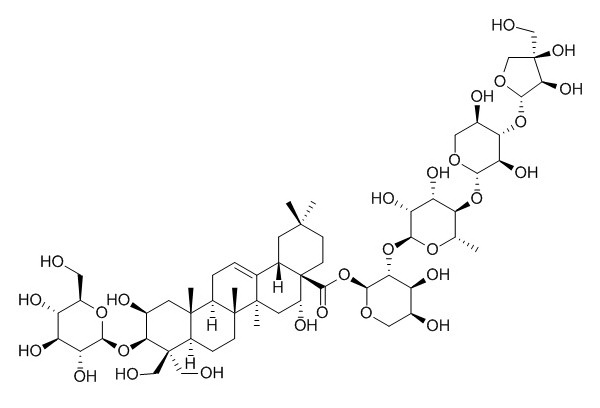Natural Products
Platycodin D
| Catalog No. | CFN98134 |  |
| CAS No. | 58479-68-8 | |
| Molecular Weight: | 1225.33 | |
| Molecular Formula | C57H92O28 | |
| DBs | [PubChem]:274952373 [ChEMBL]:70436 [PCIDB]: |
Standard InChI:
InChI=1S/C57H92O28/c1-23-40(81-45-39(72)41(28(64)18-76-45)82-49-43(73)56(75,21-61)22-78-49)36(69)38(71)46(79-23)83-42-33(66)27(63)17-77-48(42)85-50(74)57-12-11-51(2,3)13-25(57)24-7-8-30-52(4)14-26(62)44(84-47-37(70)35(68)34(67)29(16-58)80-47)55(19-59,20-60)31(52)9-10-53(30,5)54(24,6)15-32(57)65/h7,23,25-49,58-73,75H,8-22H2,1-6H3/t23-,25-,26-,27-,28+,29+,30+,31+,32+,33-,34+,35-,36-,37+,38+,39+,40-,41-,42+,43-,44-,45-,46-,47-,48-,49-,52+,53+,54+,56+,57+/m0/s1
Biological Activity
Platycodon D (PD) and D3 (PD3) isolated from Platycodon grandiflorum has been previously reported to show anti-inflammatory activities in rats, PD may stimulate TNF-α synthesis or inhibit degradation of TNF-α mRNA, suggest a dichotomous regulation of these important proinflammatory mediators by PD and PD3.[1]
Platycodin D suppresses prostaglandin E2 production at 10 and 30 uM in rat peritoneal macrophages stimulated by the protein kinase C activator 12-O-tetradecanoylphorbol 13-acetate (TPA).[2]
Platycodin D has the ability to induce apoptosis in HaCaT cells through the upregulation of Fas receptor and FasL expression via to NF-κB activation in the transcriptional level, suggests that the NF-κB activation plays a crucial role in the induction of apoptosis in human HaCaT cells on treatment with platycodin D.[3]
Platycodin D (PD) significantly promotes the production of Th1 (IL-2 and IFN-gamma) and Th2 (IL-10) cytokines and up-regulates the mRNA expression of Th1 cytokines (IL-2 and IFN-gamma) in splenocytes from the mice immunized with HBsAg, also increases the killing activities of natural killer (NK) cells and CTLs from splenocytes in the HBsAg-immunized mice, which may have important implications for vaccination against hepatitis B virus,suggests that PD may be the candidates as adjuvants for use in prophylactic and therapeutic hepatitis B vaccine.[4]
Platycodin-D(PD) can induce autophagy in NCI-H460 and A549 cells through inhibiting PI3K/Akt/mTOR signaling pathway and activating JNK and p38 MAPK signaling pathways.[5]
Platycodin D has showed an antinociceptive effect .[6]
Platycodin D can inhibit migration, invasion, and growth of MDA-MB-231 human breast cancer cells via suppression of EGFR-mediated Akt and MAPK pathways.[7]
Product
References
[1] Wang C, Levis G B S, Lee E B, et al. Int Immunopharmacol, 2004, 4(8):1039-49.
[2] Kim Y P, Lee E B, Kim S Y, et al. Planta Medica, 2001, 67(4):362-4.
[3] Ahn K S, Hahn B S, Kwack K B, et al. Eur J Pharmacoly, 2006, 537(1-3):1-11.
[4] Xie Y, Sun H X, Li D. Vaccine, 2009, 27(5):757764.
[5] Zhao R, Chen M, Jiang Z, et al. J Cancer, 2015, 6(7):623-31.
[6] SeongSoo Choi, EunJung Han, TaeHee Lee, et al. Am J Chinese Med, 2004, 32(2):257-68.
[7] Chun J, Kim Y S. Chem-Biol Interact, 2013, 205(3):212-21.
[8] Chen G, Tai S, Huang L. China Pharm, 014(18):51-3.
Product Use Citation





